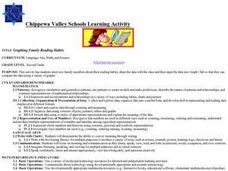Curated OER
Decimal Fractions
Students use rounding and compensating with whole numbers and explain how to use the empty number line to show additions and subtractions. They round and compensate in relation to decimal subtraction
Background
Curated OER
Guesstimate? NO Estimate!
Students discover the advantage of estimation over simple guessing using number relationships. They also discover how useful a mathematical tool estimation is in everyday life.
Curated OER
Making Estimations in Measurement
Learners utilize their knowledge of measurement in making accurate measurements and estimations.
NTTI
Putting Together Ten
Groups explore sets of 10 items in two varieties (i.e. 3 white buttons and 7 black ones, or 5 bears and 5 bunnies). They brainstorm about their objects, write math sentences to represent what they have, and report their discoveries to...
Curated OER
Graphing Family Reading Habits
Second graders collect data from their families about their reading habits and graph them. For this graphing family reading habits lesson, 2nd graders interview family members about their reading habits. They then use a graphing computer...
Curated OER
How Many in a Minute
Students estimate what they can accomplish in a minute. In this estimation lesson, students guess how many jumping jacks or stars they can draw in a minute. They get timed and see how close they are to their prediction.
Curated OER
Easy Estimation
Students use estimation as a math strategy. Students estimate the number of small snacks that are presented to them. Students count the snack items after they have estimated how many there are, before the class snack on a daily basis.
Curated OER
Thank You... Thomas Edison!
Students investigate the life of Thomas Edison. They research how he made a difference. They understand that accurate data collection is important for math. They create a chart using spreadsheet data.









